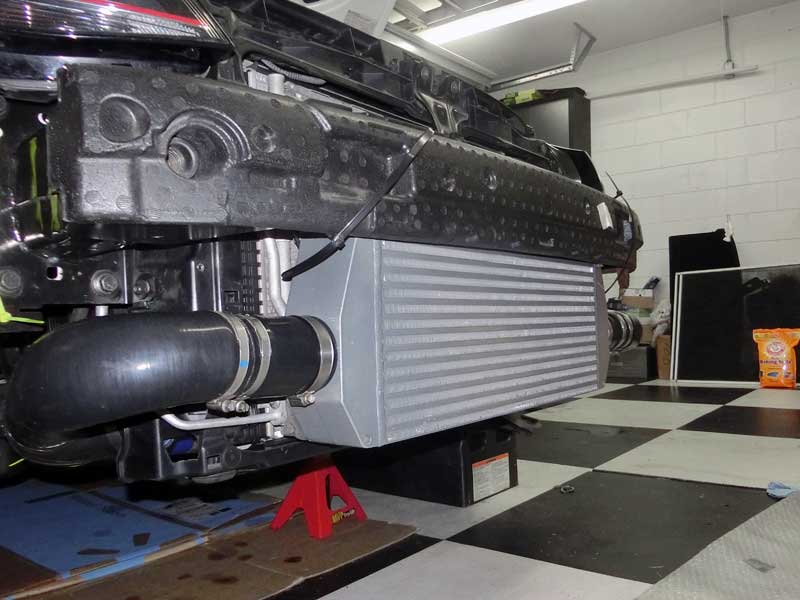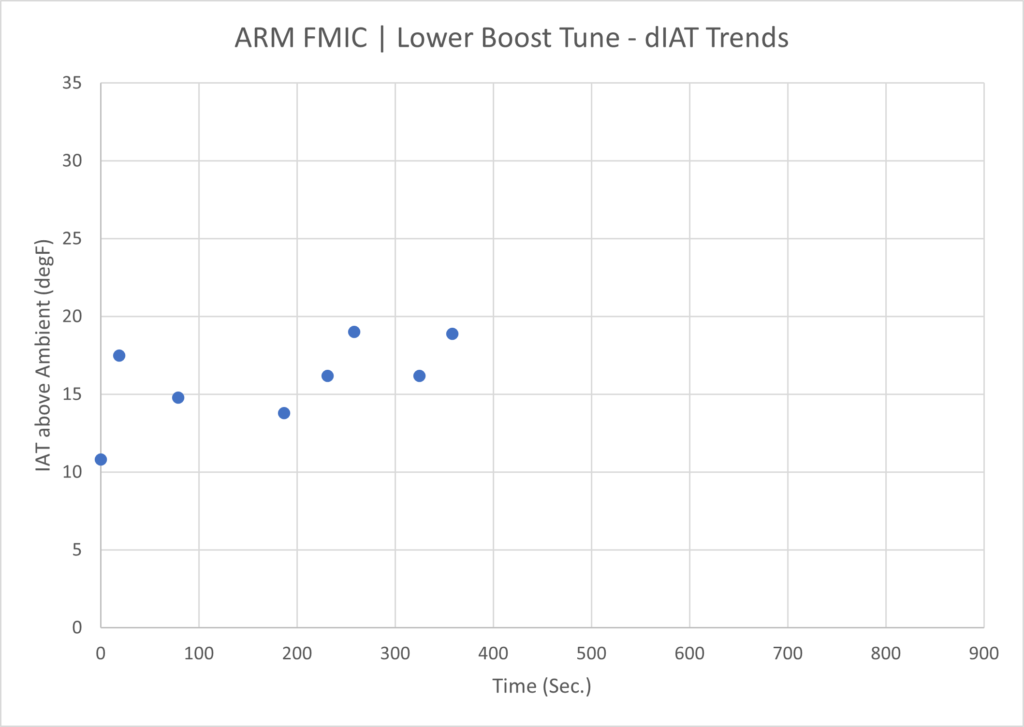Background:
ARM bicooler street data is the subject of this post. Recently somebody pointed out to me that ARM Motorsports offers a bicooler hose option for their FMIC, and the same person asked if I had used the ARM FMIC as a bicooler. “Why yes I have“, but I never made a post to detail the results.

In this post I will compare data I have from the ARM FMIC with the ARM FMIC joined with the stock GTI IC using bicooler hoses.
Test Procedure:
During the data collection the GTI is equipped with a Shuenk IS38+ turbocharger and the ECU is operating with a custom 93-octane tune from EQT.
The GTI is accelerated at full throttle while in third gear starting from approximately 2,000 RPM and concluding at approximately 6,300 RPM.
The Intake Air Temperature (IAT) sensor reading when the engine RPM is 6,000 is compared to the ambient air temperature and the difference is calculated to be the IAT delta. This IAT delta is the metric used for comparing cooling performance with other intercoolers.
There is an extra pressure sensor installed in the turbo muffler to measure the boost pressure exiting the compressor and this value is compared to the pressure inside the intake manifold to calculate the pressure drop from the turbo to the intake manifold. This value is also calculated at 6,000 RPM.
After accelerating the GTI is driven briefly out of boost before repeating the process. This process is repeated several times.
Not all data for each IC configuration is recorded during the same drive session. The consequence of this is that after the car cools and a new series of data are collected the initial temperature values are lower. This is evident in the dot trend charts in the results section.
Two data collection sessions were conducted for each configuration.
An additional session was conducted using a Cobb IS38 Off-The-Shelf (OTS) tune that operates at a lower boost pressure than the EQT tune, shown below. The data from this session is shown separately from the other results.

Test Results:
The total number of data points recorded using each configuration is shown in the IAT Delta dot plot below.
Each dot represents an individual “pull”.

It’s clear from this chart that the results from the bicooler configuration are more consistent.
Presenting this same data using Boxplots:

The above charts suggest that the bicooler is more effective at cooling the charge air, but the variability of the stock IC data introduces some uncertainty.
A t-Test is used to test the hypothesis that the two configurations have the same cooling performance.

This hypothesis is rejected, indicating the data does not support a conclusion that the systems perform similarly.
The next charts show the Temperature trends during consecutive pulls for the FMIC.
Note: The next chart shows the temperature trend operating with the Cobb IS38 tune that runs a lower boost pressure than the Stratified and EQT tunes that I am normally driving with. This chart is included because of the number of pulls that are made, but the different operating conditions should be considered when comparing with the other data presented here.

The next charts are the Temperature trends with the Bicooler.
The final comparison is of the pressure drop between the turbocharger outlet and the intake manifold at 6,000 RPM.

Conclusions:
The ARM FMIC is compared with the ARM FMIC joined with the stock GTI IC as a bicooler.
Temperature and pressure measurements are made during full-throttle acceleration.
Data shows that the bicooler has an average lower IAT as well as a more consistent output temperature and slower temperature increase during sequential pulls.
The pressure drop caused by the bicooler is approximately half the amount caused by the FMIC.
Using the methods described above for collecting data the bicooler configuration performs better than the FMIC in the comparison measures.





Seems like a no-brainer upgrade for ARM FMIC owners. Better flow + better cooling performance. And as a bonus, these cooling results agree with ARM’s claims.
In terms of performance, it looks like a beneficial option.